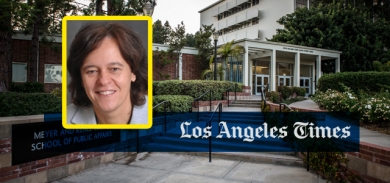Op-Ed: Turn to Europe for Models for California High-Speed Rail Stations Urban Planning professor Anastasia Loukaitou-Sideris argues in the L.A. Times that train stations should strive to connect with their communities.

In an op-ed published in the Los Angeles Times on Sunday, Urban Planning professor and Associate Dean of Academic Affairs, Anastasia Loukaitou-Sideris shines light on California’s unique opportunities in building the nation’s first bullet train.
In designing the rail system, Loukaitou-Sideris wrote that cities should focus on the extending half a mile around the station and the broader region in order to make the most of the $68 billion investment.
“The arrival of high-speed rail can provide opportunities to transform adjacent station areas and reshape local economies through thoughtful planning and policies that integrate the railway stops with the local business and physical environment,” Loukaitou-Sideris wrote in the op-ed.
Loukaitou-Sideris encouraged California to look to rail systems in Europe as examples for designing a transportation system that would build community and stimulate the economy. She provided examples of European rain systems that incorporate its surroundings in an efficient way, including Madrid’s Atocha high-speed railway terminal and Germany’s Leipizig central train station, which both serve as shopping, eating and entertainment destinations.
“The architects of stations must focus on breaking down the barriers caused by coping with a massive transportation infrastructure, employing good design to place rail tracks out of the way and to increase the station’s connectivity to its surroundings,” Loukaitou-Sideris wrote.
In addition to providing transportation to increase connectivity, Loukaitou-Sideris addressed the need to find alternate forms of transportation to access stations in order to encourage walking to attractions near the terminals. Concealing parking structures and providing bike and car sharing facilities, for instance, can encourage people to visit nearby landmarks and entertainment centers.
Loukaitou-Sideris wrote that future planning and design should consider the municipal and regional context and assets of cities in California and should connect smaller cities and larger cities.
“Smaller cities should engage in complementary planning with bigger cities…and seek to identify productive relationships with newly accessible neighboring areas,” she wrote.
With these ideas in mind, Loukaitou-Sideris argued that California has the potential to design railway stations that become city landmarks and build community in regions across California.
In addition to her work as an educator, Loukaitou-Sideris conducts research on the public environment of the city, its aesthetics and impact on residents. She focuses on seeking to integrate social and physical issues in urban planning. Loukaitou-Sideris has served as a consultant to the Transportation Research Board, Federal Highway Administration and other projects. Her published works include “Sidewalks: Conflict and Negotiation over Public Space” and numerous articles.

Leave a Reply
Want to join the discussion?Feel free to contribute!